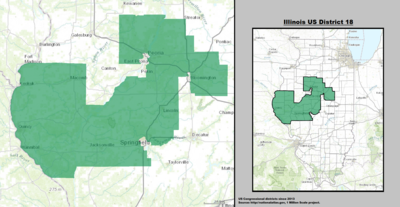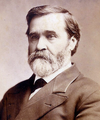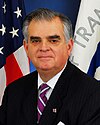Illinois's 18th congressional district
This article has multiple issues. Please help improve it or discuss these issues on the talk page. (Learn how and when to remove these template messages)
Template:Historical information needed
|
| Illinois's 18th congressional district | |||
|---|---|---|---|
 Illinois's 18th congressional district—since January 3, 2013. | |||
| Representative |
| ||
| Area | 10,516 sq mi (27,240 km2) | ||
| Distribution |
| ||
| Population (2011 est.) | 707,238 | ||
| Median household income | 54,571 | ||
| Ethnicity |
| ||
| Cook PVI | R+15[1][2] | ||
The 18th Congressional District of Illinois covers central and western Illinois, including all of Jacksonville and Quincy and parts of Bloomington, Peoria, and Springfield. Republican Aaron Schock had represented the district since January 2009, but resigned March 31, 2015.[3] Special elections were called to select Schock's replacement, with a primary on July 7 and the main election on September 10, 2015,[4] which was won by Republican State Senator Darin LaHood.[5]
Abraham Lincoln served much of the area that now lies within the 18th district for a single term; it was numbered as the 7th district at the time. It also contains most of the territory that was represented by future United States Senate Minority Leader Everett Dirksen (1933-1949. when it was the 16th District) and longtime House Minority Leader Bob Michel (1957-1995).
From 1949 to 2015, it was represented by men who attended Bradley University, and from 1957 from 2015 by a Bradley graduate.
2011 redistricting
The district covers parts of McLean, Peoria, Sangamon, Stark and Tazewell counties, and all of Adams, Brown, Cass, Hancock, Logan, Marshall, Mason, McDonough, Menard, Morgan, Pike, Schuyler, Scott and Woodford counties, as of the 2011 redistricting which followed the 2010 census. All or parts of Bloomington, Chatham, Jacksonville, Lincoln, Macomb, Morton, Normal, Peoria, Quincy and Springfield are included.[6] The representatives for these districts were elected in the 2012 primary and general elections, and the boundaries became effective on January 5, 2013.
List of representatives
| Representative | Party | Years | Electoral history | |
|---|---|---|---|---|
| District created March 4, 1873 | ||||
 Isaac Clements Isaac Clements
|
Republican | March 4, 1873 – March 3, 1875 |
Lost re-election. | |
 William Hartzell William Hartzell
|
Democratic | March 4, 1875 – March 3, 1879 |
Retired | |
 John R. Thomas John R. Thomas
|
Republican | March 4, 1879 – March 3, 1883 |
Redistricted to the 20th district | |
 William R. Morrison William R. Morrison
|
Democratic | March 4, 1883 – March 3, 1887 |
Redistricted from the 17th district. Lost re-election. | |
 Jehu Baker Jehu Baker
|
Republican | March 4, 1887 – March 3, 1889 |
Lost re-election. | |
 William S. Forman William S. Forman
|
Democratic | March 4, 1889 – March 3, 1895 |
[data missing] | |
 Frederick Remann Frederick Remann
|
Republican | March 4, 1895 – July 14, 1895 |
Died. | |
| Vacant | July 14, 1895 – December 2, 1895 | |||
 William F. L. Hadley William F. L. Hadley
|
Republican | December 2, 1895 – March 3, 1897 |
Elected to finish Remann's term. Lost re-election. | |
 Thomas M. Jett Thomas M. Jett
|
Democratic | March 4, 1897 – March 3, 1903 |
Retired. | |
 Joseph G. Cannon Joseph G. Cannon
|
Republican | March 4, 1903 – March 3, 1913 |
Redistricted from the 12th district. Lost re-election. | |
 Frank T. O'Hair Frank T. O'Hair
|
Democratic | March 4, 1913 – March 3, 1915 |
Lost re-election. | |
 Joseph G. Cannon Joseph G. Cannon
|
Republican | March 4, 1915 – March 3, 1923 |
Retired. | |
 William P. Holaday William P. Holaday
|
Republican | March 4, 1923 – March 3, 1933 |
Lost re-election. | |
 James A. Meeks James A. Meeks
|
Democratic | March 4, 1933 – January 3, 1939 |
Lost re-election. | |
 Jessie Sumner Jessie Sumner
|
Republican | January 3, 1939 – January 3, 1947 |
Retired. | |
 Edward H. Jenison Edward H. Jenison
|
Republican | January 3, 1947 – January 3, 1949 |
Redistricted to the 23rd district. | |
 Harold H. Velde Harold H. Velde
|
Republican | January 3, 1949 – January 3, 1957 |
Retired. | |
 Robert H. Michel Robert H. Michel
|
Republican | January 3, 1957 – January 3, 1995 |
Retired. | |
 Ray LaHood Ray LaHood
|
Republican | January 3, 1995 – January 3, 2009 |
Retired.[7] | |
 Aaron Schock Aaron Schock
|
Republican | January 3, 2009 – March 31, 2015 |
Resigned.[8] | |
| Vacant | March 31, 2015 – September 10, 2015 | |||
 Darin LaHood Darin LaHood
|
Republican | September 10, 2015 – Present |
Elected to finish Schock's term. | |
Election results
| Year | Democrat | Votes | Pct | Republican | Votes | Pct | |||
|---|---|---|---|---|---|---|---|---|---|
| 1994 | G. Douglas Stephens | 78,332 | 39% | Ray LaHood | 119,838 | 60% | * | ||
| 1996 | Mike Curran | 98,413 | 41% | 143,110 | 59% | ||||
| 1998 | (no candidate) | 158,175 | 100% | * | |||||
| 2000 | Joyce Harant | 85,317 | 33% | 173,706 | 67% | ||||
| 2002 | (no candidate) | 192,567 | 100% | ||||||
| 2004 | Steve Waterworth | 91,548 | 30% | 216,047 | 70% | ||||
| 2006 | 73,052 | 33% | 150,194 | 67% | |||||
| 2008 | Colleen Callahan | 117,642 | 38% | Aaron Schock | 182,589 | 59% | * | ||
| 2010 | Deirdre "D.K." Hirner | 57,046 | 26% | 152,868 | 69% | * | |||
| 2012 | Steve Waterworth | 85,164 | 244,467 | 74% | |||||
| 2014 | Darrel Miller | 62,377 | 25% | 184,363 | 75% | ||||
| 2015 (special) | Rob Mellon | 15,840 | 31% | Darin LaHood | 34,907 | 69% |
* Write-in and minor candidate notes: In 1994, write-ins received 955 votes. In 1998, write-ins received 2 votes. In 2008, Green Party candidate Sheldon Schafer received 9,857 votes. In 2010, Schafer received 11,256 votes.
2008
Ray LaHood decided not to seek re-election in 2008 and was chosen by Barack Obama to serve as U.S. Secretary of Transportation. Illinois State Representative Aaron Schock of Peoria won the seat for the Republicans in the November 4, 2008 election. His main opponent was Democrat Colleen Callahan, of Kickapoo, a radio and television broadcaster. Green Party candidate and educator Sheldon Schafer, of Peoria, was in a distant third place on the ballot.[10]
2010
Current Representative
Current representative, Darin LaHood received criticism from constituents for declining to hold an open town hall during the February 2017 recess. [11] Constituents from across the 18th congressional district gathered in Bloomington Normal and Jacksonville to request a town hall to discuss a variety of issues, including access to health care, immigration laws, and the freedom of the press. [12] [13][14] LaHood argued that he did not need to hold a town hall because he received 72% of the vote in 2016. [15]
Recent election results from presidential races
| Year | Results |
|---|---|
| 2000 | Bush 54–43% |
| 2004 | Bush 58–42% |
| 2008 | McCain 54–44%[2] |
| 2012 | Romney 61–37%[2] |
Living former members from the district
As of January 2017[update], two former members of the U.S. House of Representatives from Illinois's 18th congressional district are alive.
| Representative | Term in office | Date of birth (and age) |
|---|---|---|
| Ray LaHood | 1995–2009 | December 6, 1945 |
| Aaron Schock | 2009–2015 | May 28, 1981 |
Historical district boundaries

See also
References
- ^ "Partisan Voting Index – Districts of the 115th Congress" (PDF). The Cook Political Report. April 7, 2017. Retrieved April 7, 2017.
- ^ a b c Barone, Michael; McCutcheon, Chuck (2013). The Almanac of American Politics 2014. Chicago: University of Chicago Press. pp. 595–598. ISBN 978-0-226-10544-4. Copyright National Journal.
- ^ "Rep. Aaron Schock Plans to Resign in Wake of Spending Probe". The Washington Post. Retrieved March 17, 2015.
- ^ Garcia, Monique (April 14, 2015). "Judge sets special election dates for Schock seat in Congress". Chicago Tribune. Retrieved April 17, 2015.
- ^ "Darin LaHood wins special election to replace ex-U.S. Rep. Aaron Schock". Chicago Tribune. September 10, 2015. Retrieved September 10, 2015.
{{cite news}}: Italic or bold markup not allowed in:|publisher=(help) - ^ Illinois Congressional District 18, Illinois Board of Elections
- ^ Retirement Announcement of Rep. Ray LaHood (Part 1 of 3). YouTube. August 11, 2007. Retrieved April 17, 2015.
- ^ Sherman, Jake; Palmer, Anna; Bresnahan, John (March 17, 2015). "Aaron Schock resigns after new questions about mileage expenses". Politico.com. Arlington, Virginia. Retrieved April 17, 2015.
- ^ "Election Statistics". Office of the Clerk of the House of Representatives. Archived from the original on July 25, 2007. Retrieved October 6, 2011.
{{cite web}}: Unknown parameter|deadurl=ignored (|url-status=suggested) (help) - ^ "Elections". WEEK News 25 website. Granite Broadcasting. November 5, 2008. Archived from the original on December 10, 2008. Retrieved November 5, 2008.
{{cite web}}: Unknown parameter|deadurl=ignored (|url-status=suggested) (help) 100% of precincts reporting. Unframed data at "Archived copy". Archived from the original on April 13, 2009. Retrieved February 18, 2011.{{cite web}}: Unknown parameter|deadurl=ignored (|url-status=suggested) (help)CS1 maint: archived copy as title (link). - ^ Franke-Ruta, Garance. "Resistance Report: More than 1 million sign White House petition for Trump's tax returns, breaking record". Yahoo News. Retrieved February 25, 2017.
- ^ Blanchette, David (February 24, 2017). "U.S. Rep. LaHood criticized for dodging constituents' questions". Pekin Daily Times. Retrieved February 25, 2017.
{{cite web}}: Cite has empty unknown parameter:|dead-url=(help) - ^ Kwon, Esther (February 23, 2017). "Protesters Ask For Public Meeting With LaHood". News Channel 20. Retrieved February 25, 2017.
{{cite web}}: Cite has empty unknown parameter:|dead-url=(help) - ^ Beigh, Derek (February 24, 2017). "LaHood, protesters: B-N town hall still possible". Pantagraph. Retrieved February 25, 2017.
{{cite web}}: Cite has empty unknown parameter:|dead-url=(help) - ^ Jackson, Denise (February 20, 2017). "Protesters confront Congressman Darin Lahood about town hall meeting". 25newsWeek. Retrieved February 27, 2017.
{{cite web}}: Cite has empty unknown parameter:|dead-url=(help)
- Martis, Kenneth C. (1989). The Historical Atlas of Political Parties in the United States Congress. New York: Macmillan Publishing Company.
{{cite book}}: Cite has empty unknown parameter:|coauthors=(help) - Martis, Kenneth C. (1982). The Historical Atlas of United States Congressional Districts. New York: Macmillan Publishing Company.
{{cite book}}: Cite has empty unknown parameter:|coauthors=(help) - Congressional Biographical Directory of the United States 1774–present
